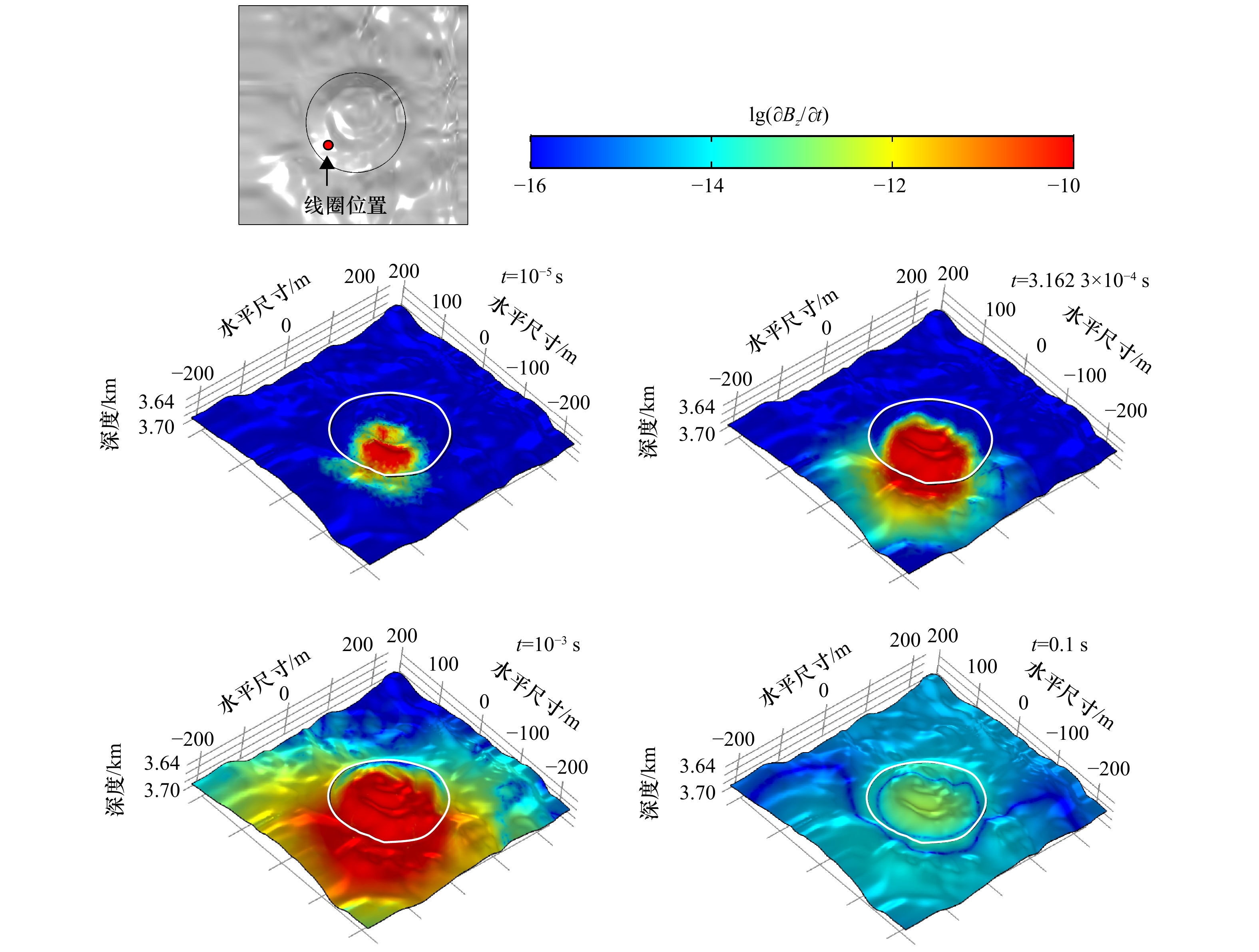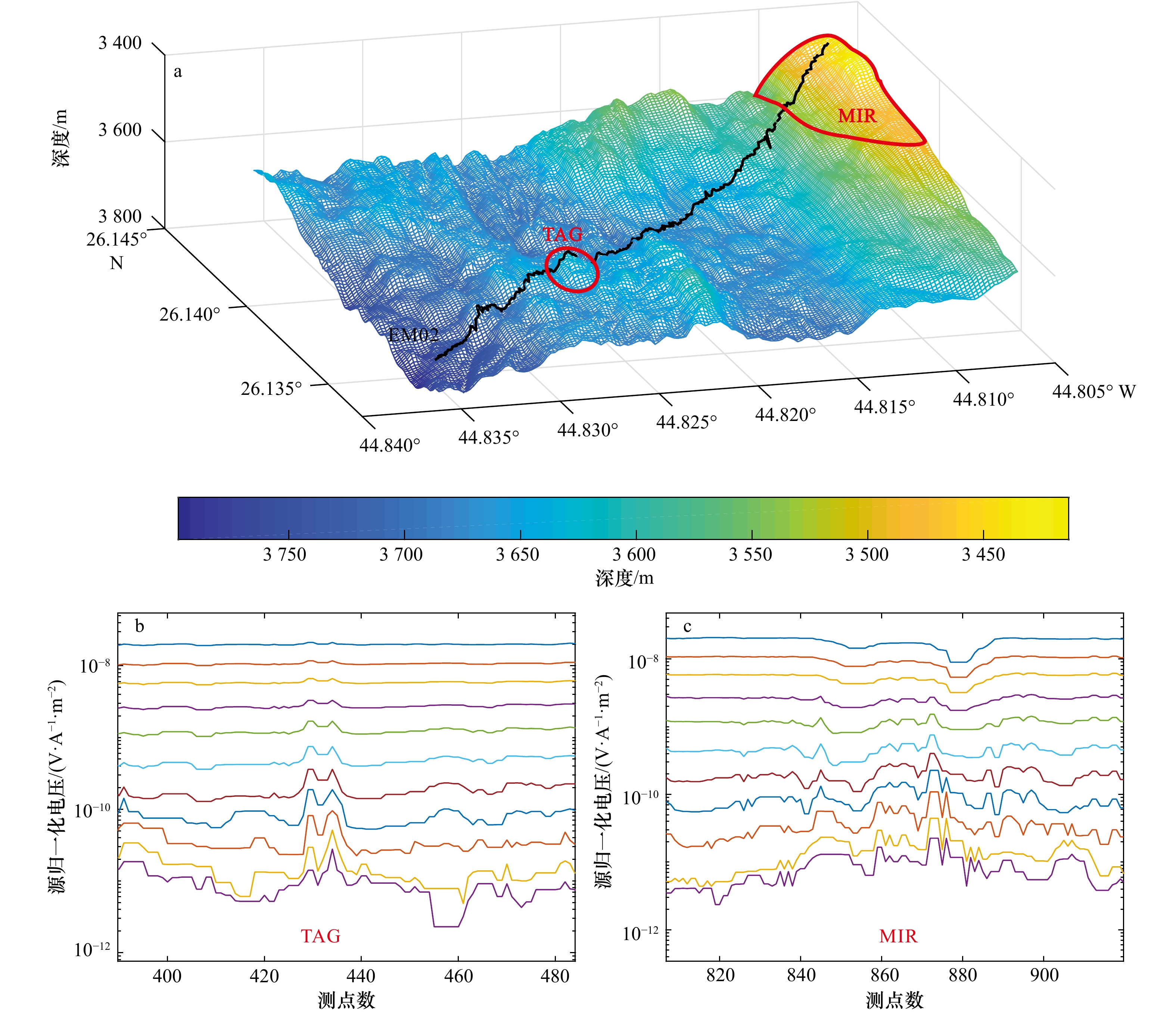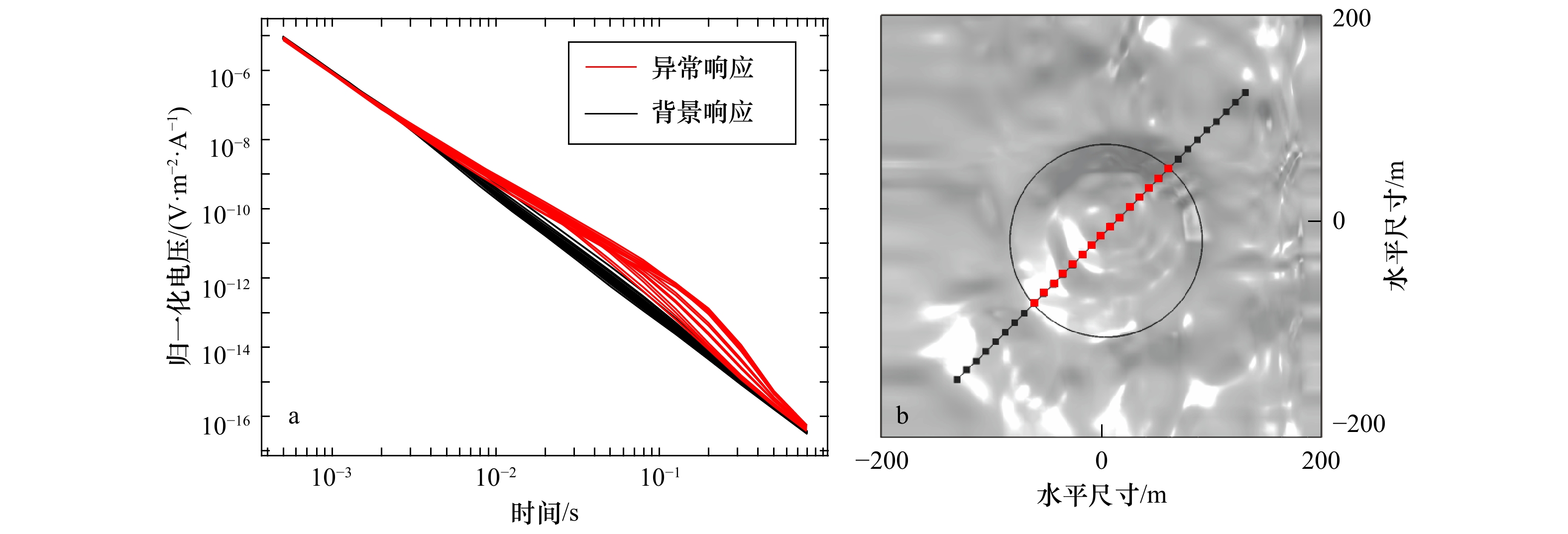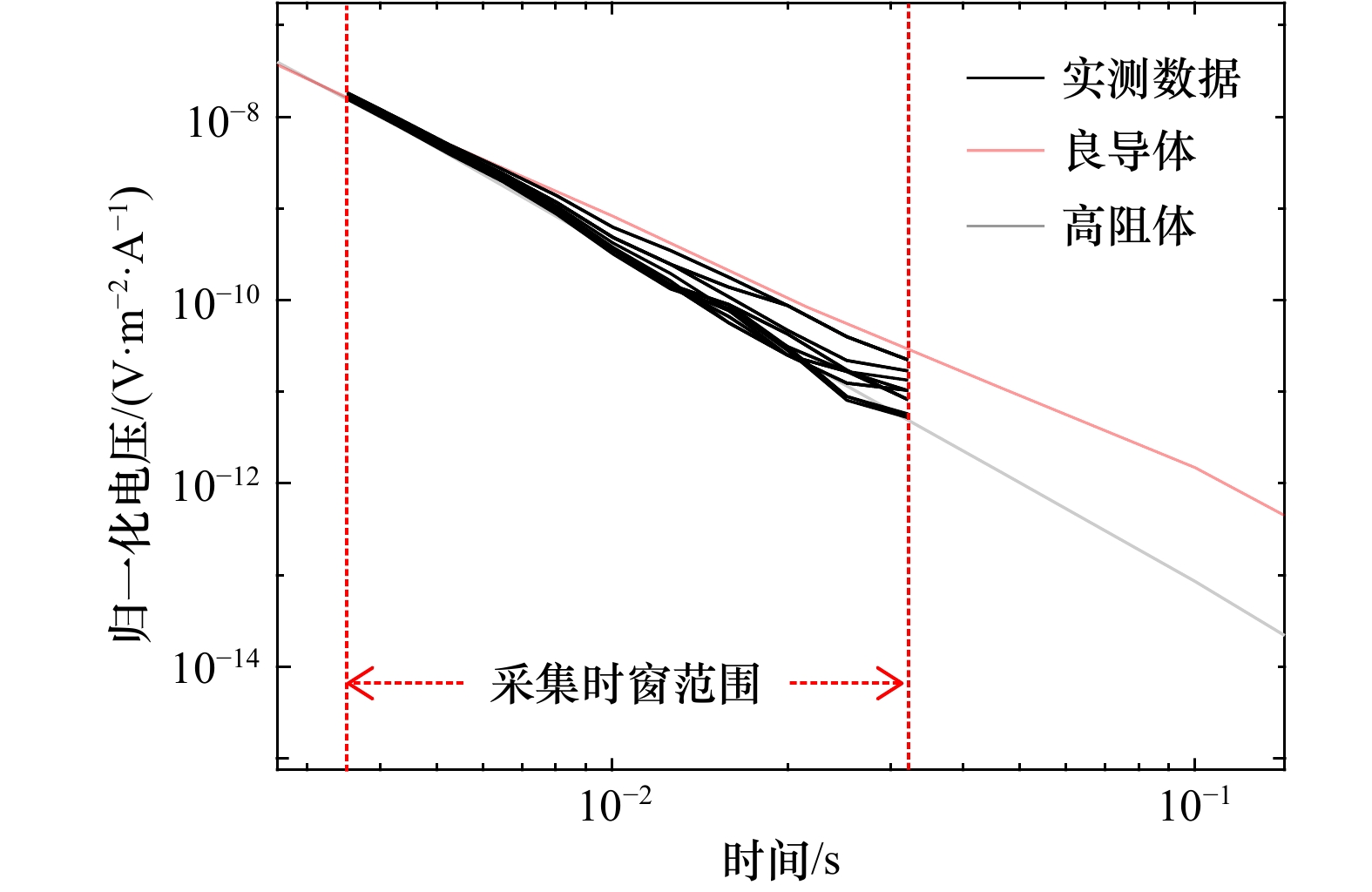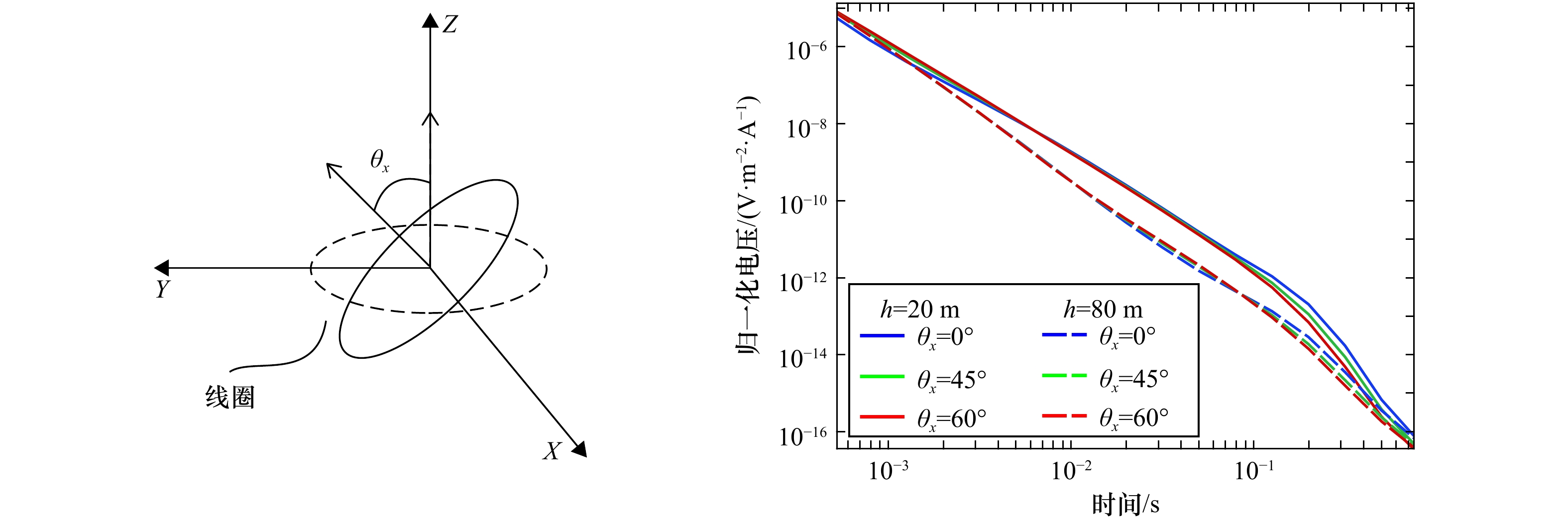3D transient electromagnetics forward modeling with complex topography and structure: A case study of the TAG hydrothermal field, Mid-Atlantic Ridge
-
摘要: 如何确定海底多金属硫化物的空间分布并对其进行资源量评价至关重要。瞬变电磁法是陆地金属矿床勘探的重要手段,但海底的崎岖地形、硫化物的复杂结构以及不稳定的近底观测条件为瞬变电磁在海洋中的应用提出了挑战。为验证瞬变电磁方法对热液区硫化物的勘探应用潜力,本文采用了有限元方法,结合大西洋洋中脊TAG热液区实测地形数据和硫化物深部剖面进行三维正演模拟,通过对比仪器在不同位置、姿态、离底高度的正演模拟结果发现:重叠回线探测装置在离底高度小于60 m时,可以有效探测到TAG丘体的高电导率异常。海底复杂地形以及仪器拖曳方式都会对二次场早期响应产生干扰,同时仪器姿态变化也会改变所探测到的响应,这表明,应结合研究区域的海底地形、仪器海底定位以及姿态数据才能更好的对实测瞬变电磁数据进行合理解释。Abstract: It is crucial to evaluate seafloor massive sulfides (SMS) in terms of their special distribution. Transient electromagnetic method (TEM) is ideal for land mineral deposits prospecting, but the complicated seafloor topography, inner structure of sulfide deposits and measuring conditions in the hydrothermal field pose a great challenge to its application in the ocean. In order to verify the application potential of TEM in deep-sea exploration, a 3D forward modeling scheme was developed with finite element method, combining with bathymetry data and drilling results. The method was then applied to the TAG hydrothermal field, Mid-Atlantic Ridge, and the result was well fitted with acquired TEM data. By comparing the forward simulation results under different instrument positions, attitudes and altitude, we found that the coincident loop system could effectively detect the active TAG mound ore body when the altitude was less than 60 meters. Complex seafloor topography and how the instrument was being towed could significantly disturb the early time response, while the instrument attitude also made an influence on the detected signal. Therefore, it was necessary to combine the bathymetry data, instrument positioning data and attitude data in the research area to better interpret the measured TEM responses.
-
图 1 大西洋洋中脊TAG热液区高分辨率地形图(a)以及TAG丘体内部地质结构(b)
白圈代表已知硫化物堆积体位置(修改自参考文献[22−23])
Fig. 1 High-resolution bathymetry map of the TAG hydrothermal field at the Mid-Atlantic Ridge (a) and the geological structure of the TAG mound (b)
The white circles mark known seafloor massive sulfide targets (figure modified from references [22−23])
图 3 TAG丘体所在区域三维电导率分布模型
a中红线代表正演模拟中测线所在位置(离底20 m);b为TAG丘体的电导率模型;c和d分别为X-Z和Y-Z剖面;e和f分别为全模型与TAG丘体的网格剖分结果
Fig. 3 3D conductivity model for the TAG mound
The red line in a is the designed survey line with the altitude of 20 m; b is the constructed conductivity model of the ore body; c and d represent the X-Z and Y-Z section; e and f are the constructed mesh for the whole model and the TAG mound respectively
图 5 发射线圈关断后,由背景场归一化后的异常场,其中第二列图为西南−东北方向的竖直剖面
Fig. 5 Forward model of the normalized
$\partial {B_z} / \partial t$ for a homogeneous seafloor model vs. the model which includes the conductive target after transmitter turned off, graphs at the second column are the SW-NE sections of the TAG mound area图 6 TAG丘体与MIR区周边多波束地形图及大洋26航次瞬变电磁EM02测线(a)、TAG丘体瞬变电磁归一化响应平剖图(b)和MIR区瞬变电磁归一化响应平剖图(c)
平剖图中曲线的不同颜色代表采集时间,3~30 ms按对数采样共11道
Fig. 6 The multibeam bathymetry of the area contains the TAG mound and the MIR zone with the EM02 survey line from COMRA 26th Cruise (a), normalized section of TEM response at the TAG mound (b), and normalized section of TEM response at the MIR zone (c)
The different colors refer to different sampling time, with a total of 11 traces from 3 ms to 30 ms logarithmically
图 8 TAG热液区部分实测瞬变电磁数据
良导体指上半空间是电导率为3 S/m的海水,下半空间是电导率为60 S/m的硫化物;高阻体指上半空间是电导率为3 S/m的海水,下半空间是电导率为0.1 S/m的玄武岩
Fig. 8 Part of the collected TEM data at the TAG hydrothermal field
Highly conductive body refers to the seawater with conductivity of 3 S/m in the upper half space, while sulfide with conductivity of 60 S/m in the lower half space; highly resistive body refers to seawater with conductivity of 3 S/m in the upper half space and basalt with conductivity of 0.1 S/m in the lower half space
图 9 不同离底高度下的电压平剖图(a)和对应测线轨迹(b)
瞬变电磁响应时窗范围为3.1~30 ms, 以对数间隔采样,虚线所指的背景场响应为离底高度80 m时的纯高阻海底响应,方框虚线为30 ms时的背景场响应,该时刻为大洋26航次实测数据中可探测到的最晚时刻
Fig. 9 Section of TEM response under different survey altitudes (a) and the corresponding survey lines (b)
The time window for the transient electromagnetic method response is from 3.1 ms to 30 ms in a logarithmic manner, the dashed line is the background response from a homogeneous seafloor model with high resistivity at 80 m altitude. The squared line refers to the background response at 30 ms, which is the latest time that can be detected by TEM survey during the COMRA 26th Cruise
表 1 TAG热液区样品及部分陆地玄武岩样品的电导率测量结果[23−24]
Tab. 1 Conductivity measurement results of sulfide samples from the TAG hydrothermal field and various onshore basalt samples[23−24]
采样位置 样品描述 密度/(kg·m−3) 孔隙度/% 电导率/(S·m−1) N of Kane转换断层 玄武岩 2 819 6.5 0.05 塞浦路斯 蚀变玄武岩 2 383 20.3 0.29 Southern mound, TAG 黄铁矿 4 454 9.8 1 315 Shinkai mound, TAG 黄铁矿、二氧化硅 2 361 23.9 3.03 Rona mound, TAG 黄铁矿、黄铜矿 4 365 8.8 66.67 -
[1] Rona P A, McGregor B A, Betzer P R, et al. Anomalous water temperatures over Mid-Atlantic Ridge crest at 26° North latitude[J]. Deep Sea Research and Oceanographic Abstracts, 1975, 22(9): 611−618. doi: 10.1016/0011-7471(75)90048-0 [2] Rona P A, Thompson G, Mottl M J, et al. Hydrothermal activity at the Trans-Atlantic Geotraverse hydrothermal field, Mid-Atlantic ridge crest at 26°N[J]. Journal of Geophysical Research: Solid Earth, 1984, 89(B13): 11365−11377. doi: 10.1029/JB089iB13p11365 [3] 陶春辉. 洋中脊多金属硫化物勘查方法与技术[M]. 北京: 科学出版社, 2018.Tao Chunhui. Exploration Methods and Techniques for Polymetallic Sulfide on the Mid-Ocean Ridges[M]. Beijing: Science Press, 2018. [4] Humphris S E, Herzig P M, Miller D J, et al. The internal structure of an active sea-floor massive sulphide deposit[J]. Nature, 1995, 377(6551): 713−716. doi: 10.1038/377713a0 [5] Lehrmann B, Stobbs I J, Lusty P A J, et al. Insights into extinct seafloor massive sulfide mounds at the TAG, Mid-Atlantic Ridge[J]. Minerals, 2018, 8(7): 302. doi: 10.3390/min8070302 [6] Edwards R N, Chave A D. A transient electric dipole-dipole method for mapping the conductivity of the sea floor[J]. Geophysics, 1986, 51(4): 984−987. doi: 10.1190/1.1442156 [7] Cheesman S J, Edwards R N, Chavez A D. On the theory of sea-floor conductivity mapping using transient electromagnetic systems[J]. Geophysics, 1987, 52(2): 204−217. doi: 10.1190/1.1442296 [8] Everett M E, Edwards R N, Cheesman S J, et al. Interpretation of seafloor electromagnetic data in applied geophysics[C]//Proceedings of the First International Symposium, Applied Electromagnetics in Materials. Tokyo: Applied Electromagnetics in Materials, 1989: 143−153. [9] Swidinsky A, Hölz S, Jegen M. On mapping seafloor mineral deposits with central loop transient electromagnetics[J]. Geophysics, 2012, 77(3): E171−E184. doi: 10.1190/geo2011-0242.1 [10] Hölz S, Jegen M, Petersen S, et al. How to find buried and inactive seafloor massive sulfides using transient electromagnetics—a case study from the Palinuro Seamount in the Tyrrhenian Sea[R]. Dassel, Germany: EMTF Meeting, 2015. [11] Tao Chunhui, XiongWei, Xi Zhenzhu, et al. TEM investigations of South Atlantic Ridge 13.2°S hydrothermal area[J]. Acta Oceanologica Sinica, 2013(12): 70−76. [12] 熊威, 陶春辉, 邓显明. 电磁方法在海底多金属硫化物探测中的应用[J]. 海洋学研究, 2013, 31(2): 59−64.Xiong Wei, Tao Chunhui, Deng Xianming. Application of electromagnetic methods in detection of seafloor polymetallic sulfides[J]. Journal of Marine Sciences, 2013, 31(2): 59−64. [13] 席振铢, 李瑞雪, 宋刚, 等. 深海热液金属硫化物矿电性结构[J]. 地球科学, 2016, 41(8): 1395−1401.Xi Zhenzhu, Li Ruixue, Song Gang, et al. Electrical structure of sea-floor hydrothermal sulfide deposits[J]. Earth Science, 2016, 41(8): 1395−1401. [14] 李瑞雪, 王鹤, 席振铢, 等. 深海热液硫化物矿体3D瞬变电磁正演[J]. 地球物理学报, 2016, 59(12): 4505−4512.Li Ruixue, Wang He, Xi Zhenzhu, et al. The 3D transient electromagnetic forward modeling of volcanogenic massive sulfide ore deposits[J]. Chinese Journal of Geophysics, 2016, 59(12): 4505−4512. [15] Zhang Bo, Yin Changchun, Ren Xiuyan, et al. Adaptive finite element for 3D time-domain airborne electromagnetic modeling based on hybrid posterior error estimation[J]. Geophysics, 2018, 83(2): WB71−WB79. doi: 10.1190/geo2017-0544.1 [16] 殷长春, 惠哲剑, 张博, 等. 起伏海底地形时间域海洋电磁三维自适应正演模拟[J]. 地球物理学报, 2019, 62(5): 1942−1953.Yin Changchun, Hui Zhejian, Zhang Bo, et al. 3D adaptive forward modeling for time-domain marine CSEM over topographic seafloor[J]. Chinese Journal of Geophysics, 2019, 62(5): 1942−1953. [17] Peng Ronghua, Han Bo, Hu Xiangyun. Exploration of seafloor massive sulfide deposits with fixed-offset marine controlled source electromagnetic method: numerical simulations and the effects of electrical anisotropy[J]. Minerals, 2020, 10(5): 457. doi: 10.3390/min10050457 [18] Hölz S, Haroon A, Reeck K, et al. MARTEMIS−A new EM tool for the detection of buried seafloor massive sulfides[R]. 24th International EM Induction Workshop, Helsingør, Denmark. 2018. [19] Haroon A, Hölz S, Gehrmann R A S, et al. Marine dipole-dipole controlled source electromagnetic and coincident-loop transient electromagnetic experiments to detect seafloor massive sulphides: effects of three-dimensional bathymetry[J]. Geophysical Journal International, 2018, 215(3): 2156−2171. doi: 10.1093/gji/ggy398 [20] Humphris S E, Tivey M K, Tivey M A. The Trans-Atlantic Geotraverse hydrothermal field: a hydrothermal system on an active detachment fault[J]. Deep-Sea Research Part II: Topical Studies in Oceanography, 2015, 121: 8−16. doi: 10.1016/j.dsr2.2015.02.015 [21] Hannington M D, Galley A G, Herzig P M, et al. Comparison of the TAG mound and stockwork complex with Cyprus-type massive sulfide deposits[J]. Proceedings of the Ocean Drilling Program: Scientific Results, 1998, 158: 389−415. [22] Murton B J, Lehrmann B, Dutrieux A M, et al. Geological fate of seafloor massive sulphides at the TAG hydrothermal field (Mid-Atlantic Ridge)[J]. Ore Geology Reviews, 2019, 107: 903−925. doi: 10.1016/j.oregeorev.2019.03.005 [23] Gehrmann R A S, North L A, Graber S, et al. Marine mineral exploration with controlled source electromagnetics at the TAG hydrothermal field, 26°N Mid-Atlantic ridge[J]. Geophysical Research Letters, 2019, 46(11): 5808−5816. doi: 10.1029/2019GL082928 [24] Gehrmann R A S, North L J, Lehrmann B, et al. Rock physic samples from TAG, Mid-Atlantic Ridge, and various onshore samples[Z]. PANGAEA, 2019. [25] Archie G. The electrical resistivity log as an aid in determining some reservoir characteristics[J]. Transactions of the American Institute of Mining Metallurgical and Petroleum Engineers, 1942, 146: 54−62. [26] Spagnoli G, Hannington M, Bairlein K, et al. Electrical properties of seafloor massive sulfides[J]. Geo-Marine Letters, 2016, 36(3): 235−245. doi: 10.1007/s00367-016-0439-5 [27] 汤井田, 任政勇, 化希瑞. Coulomb规范下地电磁场的自适应有限元模拟的理论分析[J]. 地球物理学报, 2007, 50(5): 1584−1594.Tang Jingtian, Ren Zhengyong, Hua Xirui. Theoretical analysis of geo-electromagnetic modeling on Coulomb gauged potentials by adaptive finite element method[J]. Chinese Journal of Geophysics, 2007, 50(5): 1584−1594. [28] Badea E A, Everett M E, Newman G A, et al. Finite-element analysis of controlled-source electromagnetic induction using Coulomb-gauged potentials[J]. Geophysics, 2001, 66(3): 786−799. doi: 10.1190/1.1444968 [29] Haber E, Ascher U, Oldenburg D W. 3D forward modelling of time domain electromagnetic data[J]. SEG Technical Program Expanded Abstracts, 2002, 21(1): 2478. [30] Um E S, Harris J M, Alumbaugh D L. 3D time-domain simulation of electromagnetic diffusion phenomena: a finite-element electric-field approach[J]. Geophysics, 2010, 75(4): F115−F126. doi: 10.1190/1.3473694 [31] Petersen S. Bathymetric data products from AUV dives during METEOR cruise M127 (TAG Hydrothermal Field, Atlantic)[Z]. PANGAEA, 2019. [32] Gould N I M, Scott J A, Hu Yifan. A numerical evaluation of sparse direct solvers for the solution of large sparse symmetric linear systems of equations[J]. ACM Transactions on Mathematical Software, 2007, 33(2): 10. doi: 10.1145/1236463.1236465 [33] 米萨克 N 纳比吉安. 勘查地球物理电磁法 第一卷: 理论[M]. 赵经祥, 王艳君, 译. 北京: 地质出版社, 1992.Nabighian M N. Electromagnetic Methods in Applied Geophysics Volume One: Theory[M]. Zhao Jingxiang, Wang Yanjun, trans. Beijing: Geological Publishing House, 1992. [34] 牛之琏. 时间域电磁法原理[M]. 长沙: 中南大学出版社, 2007.Niu Zhilian. Principle of Time Domain Electromagnetic Method[M]. Changsha: Central South University Press, 2007. -





 下载:
下载:


